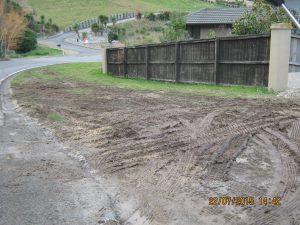Specific Tasks
Small sites
What, why, and issues to look out for
What
A common example of a ‘small site’ is a house build on an individual lot after the bulk earthworks for the development have been done. The ground disturbance caused by these individual projects is on a much smaller scale than that of the initial development, but it tends to have a significant cumulative effect. In Canterbury and New Zealand as a whole, erosion and sediment control on small sites are typically not yet handled well.
When erosion and sediment control is handled well on a small site, the benefits include:
- All-weather site access
- Improved wet-weather working conditions
- Improved drainage and reduced site wetness
- Reduced average construction time
- Fewer problems with mud and dust
- Reduced stockpile losses
- Reduced clean-up costs
- Fewer complaints and better public image.
- Compliance with regulations
- Protection of water quality in receiving waterways.
Before you start to disturb land on a small site, look at where water will run across the land and discharge from the property. Work out how the project will progress, the erosion controls you’ll need and the sediment control tools that will work best. Involve everyone working on the site in minimising all sources of pollution from the site, whether it is sediment from excavation or contractors’ vehicles parking on and making a mess of the verge, or washwater clean up from blocklaying, plastering and painting.
Why
It is an urgent priority for local contractors to commit to erosion and sediment control practices on small sites. Proportionally, it is often on these sites where the worst sediment control arises. And because these sites may be close together, the damaging effects quickly become cumulative.
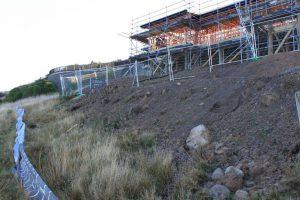
Poor erosion and sediment control practices on a building site—this pollutes local waterways and coasts and runs the risk of enforcement action.
Issues to look out for
Uncontrolled erosion and sediment on a small site can cause:
- Damage to the building site and structural damage to foundations, retaining walls, underground services and other structures
- Public safety problems when soil, litter and debris is washed onto roads and intersections
- Blocked gutters and stormwater reticulation, soakage and treatment systems, creating flooding and increased council maintenance costs
- Loss of good topsoil
- Pollution of receiving waters
- Loss of aquatic habitat and reduced biodiversity.
House construction also create other wastes which can be transported via the stormwater system directly into waterways if not operated or cleaned up appropriately, including from:
- Concreting
- Concrete or brick cutting
- Bricklaying
- Brick cleaning
- Plastering
- Tiling
- Painting
- Sediment from disturbance of the verge adjacent to the building site.
Design essentials
Builders should consult the Builders Pocket Guide, which is specific to Canterbury. It contains helpful information on:
- Best practices for your building site
- How to control and minimise your environmental impact
- How to prevent erosion and sediment run-off on site reaching gutters, drains, streams and rivers.
There is also useful information and specific advice on best practice ESC for small earthworks sites such as housing/building sites, in Auckland Council’s Builder’s Enviro Guide: Preventing pollution from your building project (PDF 8.99 MB).
In general, you will be calling on all the tools within this toolbox, in a mix and match approach. Because of the small size of the site, you need to understand the principles and correct uses of the tools you use, and apply these to suit your site. For example, stabilised entranceways are still very important, but you may not be able to achieve all of the specifications detailed in our stabilised entranceways section. The dimensions will be dictated by the available space, but you still need to design the stabilised entranceway to provide for likely vehicle movements and to meet the same outcomes.
This is also a field where new techniques arise all the time – for example, recent good practice that has arisen includes using:
- Compost blankets to cover exposed soil – 5cm deep
- Copolymer to treat exposed soils and stockpiles.
Contact us with your examples, and tools in this toolbox will be updated.
-
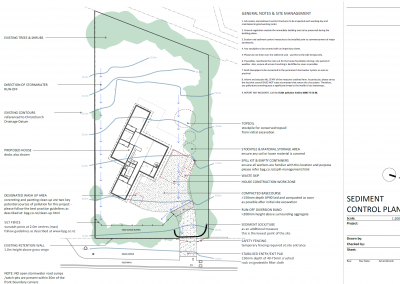
Prepare and follow a comprehensive erosion and sediment control plan for your construction site. The more challenging the site, the greater the level of controls required in your plan and practices. (Source: Andrew Trotter Landscape Design).
-
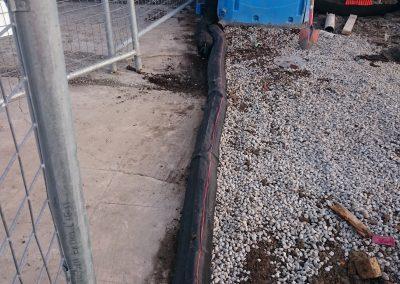
Silt socks are key equipment for retaining sediment on construction sites – move them aside when vehicles need access, so they stay effective. (source: RST Solutions Limited).
-
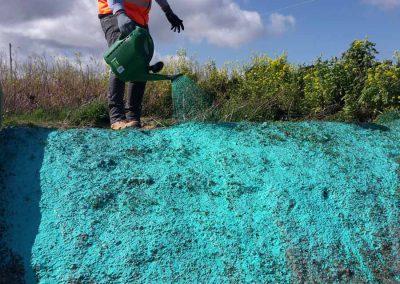
Apply soil binders to minimise erosion from disturbed soils on constructions sites. Take care to achieve 100% coverage. Using this tool may reduce erosion from exposed soils by more than 90%. (Source: Vital Pty).
Recommended sequence of work
- Take a smart approach to multi-lot developments for developers and builders
- Pre-construction planning and site layout
- Provide stabilised all-weather access
- Control water at the top of the site
- Control sediment at the foot of the site
- Put all stockpiles and building materials within the sediment control zone
- Connect all downpipes as soon as possible
- Manage litter and building wastes, especially concrete
- Promptly stabilise service trenching and other areas of exposed soil
- Maintain and carefully decommission control measures and stabilise the site.

